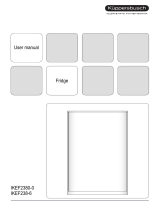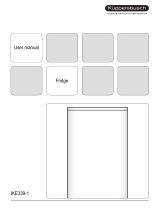Liebherr TP 1760 Premium Operating instructions
- Category
- Fridge-freezers
- Type
- Operating instructions
This manual is also suitable for
Liebherr TP 1760 Premium: With its innovative features, the Liebherr TP 1760 Premium countertop fridge offers a convenient and energy-efficient way to store and cool your food and drinks. Equipped with adjustable shelves and compartments, this compact fridge provides flexible storage options, allowing you to organize your items according to your needs. The LED interior illumination ensures clear visibility, while the childproofing function adds an extra layer of safety.
Liebherr TP 1760 Premium: With its innovative features, the Liebherr TP 1760 Premium countertop fridge offers a convenient and energy-efficient way to store and cool your food and drinks. Equipped with adjustable shelves and compartments, this compact fridge provides flexible storage options, allowing you to organize your items according to your needs. The LED interior illumination ensures clear visibility, while the childproofing function adds an extra layer of safety.














-
 1
1
-
 2
2
-
 3
3
-
 4
4
-
 5
5
-
 6
6
-
 7
7
-
 8
8
-
 9
9
-
 10
10
-
 11
11
-
 12
12
-
 13
13
-
 14
14
Liebherr TP 1760 Premium Operating instructions
- Category
- Fridge-freezers
- Type
- Operating instructions
- This manual is also suitable for
Liebherr TP 1760 Premium: With its innovative features, the Liebherr TP 1760 Premium countertop fridge offers a convenient and energy-efficient way to store and cool your food and drinks. Equipped with adjustable shelves and compartments, this compact fridge provides flexible storage options, allowing you to organize your items according to your needs. The LED interior illumination ensures clear visibility, while the childproofing function adds an extra layer of safety.
Ask a question and I''ll find the answer in the document
Finding information in a document is now easier with AI
Related papers
-
Liebherr UIK 1510 Comfort Operating instructions
-
Liebherr TX 1021 COMFORT Operating instructions
-
Liebherr 7085400-01 User manual
-
Liebherr SUIK1510RH User manual
-
Liebherr IK 2214 Comfort Operating instructions
-
Liebherr K230 Operating instructions
-
Liebherr UK 1720 Comfort Operating instructions
-
Liebherr IKP 2060 Premium Operating instructions
-
Liebherr K 2630 Comfort Operating instructions
-
Liebherr SGN 3036 Comfort Owner's manual
Other documents
-
Aeg-Electrolux SK88840-4I User manual
-
Aeg-Electrolux SK81243-4I User manual
-
Aeg-Electrolux SK81243-4I User manual
-
 Küppersbusch IKEF238-6 User manual
Küppersbusch IKEF238-6 User manual
-
 Kuppersbusch USA IKE339-1 User manual
Kuppersbusch USA IKE339-1 User manual
-
 Kuppersbusch USA IKE339-1 User manual
Kuppersbusch USA IKE339-1 User manual
-
Juno JKI9430 User manual
-
Beko HSA46330 User manual
-
Juno-Electrolux JKI9428 User manual
-
Juno-Electrolux JKI9428 User manual
















